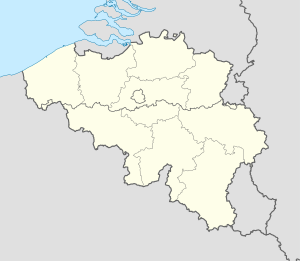
Back קרב רכס אלסנבורן HE Battaglia del crinale di Elsenborn Italian Bitwa o grzbiet Elsenborn Polish Batalha de Elsenborn Ridge Portuguese எல்சென்போர்ன் முகடு சண்டை Tamil
| Battle of Elsenborn Ridge | |||||||
|---|---|---|---|---|---|---|---|
| Part of the Battle of the Bulge | |||||||
 Discarded artillery shell casings litter a U.S. artillery position on Elsenborn Ridge. | |||||||
| |||||||
| Belligerents | |||||||
|
|
| ||||||
| Commanders and leaders | |||||||
| Units involved | |||||||
| |||||||
| Strength | |||||||
| 38,000 men initially, increasing to >80,000 | 56,000 men initially | ||||||
| Casualties and losses | |||||||
| |||||||
Location within Belgium | |||||||
The Battle of Elsenborn Ridge refers to the northernmost German attacks during the Battle of the Bulge. The area from Elsenborn Ridge itself to Monschau was the only sector of the American front line attacked during the Battle of the Bulge in which the Germans failed to advance.[6]: 33 The battle centred on the boomerang-shaped Elsenborn Ridge east of Elsenborn, Belgium. In this region, Elsenborn Ridge marks the westernmost ridge of the Ardennes, rising more than 2,000 feet (600 m) above sea level; unlike the uplands further north, east and south, it has been extensively logged. West of Elsenborn Ridge, where the land descends in gentle hills to the cities of Liège and Spa, was a network of Allied supply bases and a well-developed road network. The Germans planned on using two key routes through the area to seize Antwerp and force a separate peace with the United States and Britain.[7]: 259–271 Capturing Monschau, the nearby village of Höfen, and the twin villages of Rocherath-Krinkelt just east of Elsenborn Ridge, were key to the success of the German plans, and Hitler committed his best armored units to the area.
The untested troops of the US 99th Infantry Division had been placed in the sector during mid-November because the Allies thought that the area was unlikely to see battle. The division was stretched thin over a 22-mile (35 km) front, and all three regiments were in the line with no reserve. In early December, the 2nd Infantry Division was assigned to capture a road junction named Wahlerscheid, at the southern tip of the Hurtgen Forest. German forces counterattacked in what the Americans initially thought was a localized spoiling action, but was actually a leading element of the Battle of the Bulge. The 2nd Division consolidated its lines, pulling back into Hünningen, then Rocherath-Krinkelt, and finally to the dug-in positions held by the 99th Division at Elsenborn Ridge.
In a fierce battle lasting ten days, the American and German lines were often confused. During the first three days, the battle raged in and around Rocherath-Krinkelt. Attacking Elsenborn Ridge itself, the Germans employed effective combined arms tactics and penetrated the American lines several times, but their attacks were not well coordinated and were frustrated by the rugged terrain and the built-up area. To push the Germans back, the U.S. Army called in indirect fire on their own positions, and at one point rushed clerks and headquarters personnel to reinforce their lines. The Americans had positioned considerable artillery behind Elsenborn Ridge and these artillery batteries repeatedly pounded the German advance. The Germans, although possessing superior armor and numbers, were held in check by the Americans' well-prepared defensive positions, new proximity fuses for artillery shells, and innovative tactics, which included coordinated time on target artillery strikes.
The Sixth Panzer Army was unable to take its immediate objectives on the Meuse River. The stubborn American resistance forced Kampfgruppe Peiper to choose an alternative route well south of Monschau and Elsenborn Ridge. Peiper was able to advance about 46 kilometres (29 mi) west to Stoumont before his column was stopped by the 2nd Infantry Division, 30th Infantry Division, and the 82nd Airborne. In the end he ran out of fuel and ammunition. On 24 December, Peiper abandoned his vehicles and retreated with the remaining 800 men. German wounded and American prisoners were also left behind.[8]: 118–119 According to Peiper, 717 men returned to the German lines out of about 3,000 at the beginning of the operation.[3][9]: 113
During the battle the Americans lost about 5,000 men killed, and many more wounded; exact German losses are not known, but they included significant amounts of armor. While the Americans had considerable supplies and enough troops to replace their losses, German losses could not be replaced.
- ^ Dean, Rob. "Why the Bulge Didn't Break: Green Troops Grew Up Fast to Become Heroes of Hofen". American Forces in World War II. Military History Online. Archived from the original on 25 February 2009. Retrieved 17 March 2009.
- ^ "The Battle of Elsenborn Ridge (V Corps Holds the Line)". 1 April 2015. Archived from the original on 30 January 2018. Retrieved 29 January 2018.
- ^ a b "1st SS-Aufklärungs-Abteilung Leibstandarte SS "Adolf Hitler"". www.axishistory.com. Archived from the original on 11 January 2022. Retrieved 11 January 2022.
- ^ Mitchum, Samuel (2006). Panzers in Winter; Hitler's Army and the Battle of the Bulge. Greenwood. p. 160.
- ^ Parker, Danny S. (2014). Hitler's Warrior: The Life and Wars of SS Colonel Jochen Peiper. Da Capo Press. ISBN 978-0306821547.
- ^ Cite error: The named reference
Zalogawas invoked but never defined (see the help page). - ^ Cite error: The named reference
Colewas invoked but never defined (see the help page). - ^ Cite error: The named reference
Westemeierwas invoked but never defined (see the help page). - ^ Parker, Danny S. (2014). Hitler's Warrior: The Life and Wars of SS Colonel Jochen Peiper. Da Capo Press. ISBN 978-0306821547.
© MMXXIII Rich X Search. We shall prevail. All rights reserved. Rich X Search
